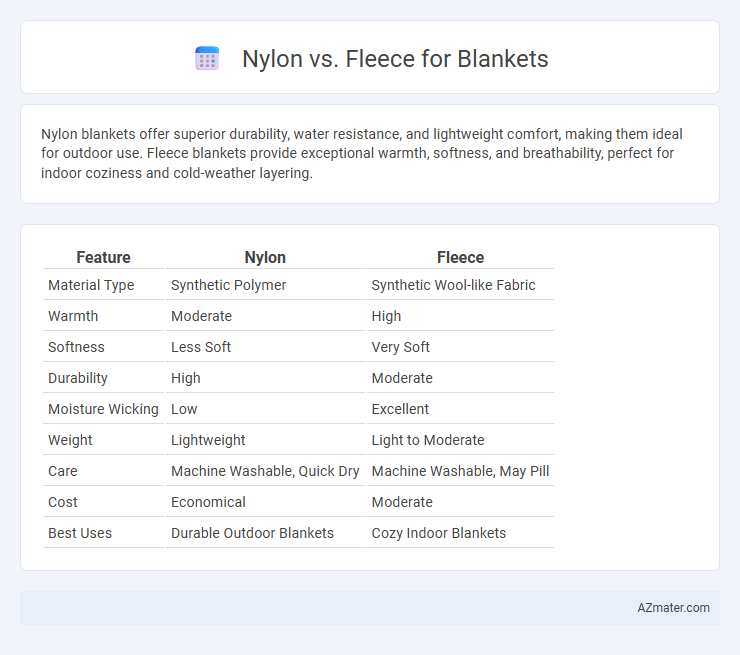Nylon blankets offer superior durability, water resistance, and lightweight comfort, making them ideal for outdoor use. Fleece blankets provide exceptional warmth, softness, and breathability, perfect for indoor coziness and cold-weather layering.
Table of Comparison
| Feature | Nylon | Fleece |
|---|---|---|
| Material Type | Synthetic Polymer | Synthetic Wool-like Fabric |
| Warmth | Moderate | High |
| Softness | Less Soft | Very Soft |
| Durability | High | Moderate |
| Moisture Wicking | Low | Excellent |
| Weight | Lightweight | Light to Moderate |
| Care | Machine Washable, Quick Dry | Machine Washable, May Pill |
| Cost | Economical | Moderate |
| Best Uses | Durable Outdoor Blankets | Cozy Indoor Blankets |
Introduction to Nylon and Fleece Blankets
Nylon blankets are known for their durability, lightweight nature, and resistance to water and mildew, making them ideal for outdoor use and travel. Fleece blankets, made from synthetic polyester fibers, provide exceptional warmth, softness, and breathability, perfect for cozy indoor settings. Both materials offer unique benefits: nylon excels in practicality and weather resistance, while fleece prioritizes comfort and insulation.
Material Composition and Characteristics
Nylon blankets are made from synthetic polyamide fibers known for their high durability, moisture resistance, and lightweight properties, making them ideal for outdoor use. Fleece blankets consist of polyester fibers designed to mimic wool, offering excellent warmth, breathability, and softness, which provides superior comfort indoors. The moisture-wicking ability of fleece contrasts with nylon's quick-drying feature, influencing their suitability based on climate and usage preferences.
Warmth Comparison: Which Retains Heat Better?
Nylon blankets are lightweight and water-resistant but offer limited insulation compared to fleece, making them less effective at retaining heat. Fleece blankets are crafted from synthetic fibers designed to trap body heat, providing superior warmth and coziness in cold conditions. For optimal heat retention, fleece is the preferred choice due to its dense pile and ability to wick moisture away while maintaining thermal insulation.
Softness and Comfort: Feel on the Skin
Nylon blankets offer a smooth, lightweight texture that feels cool and slightly slick against the skin, making them ideal for warmer climates or those who prefer less insulation. Fleece blankets provide exceptional softness with a plush, velvety surface that traps warmth while remaining breathable, enhancing overall comfort. The choice between nylon and fleece for blankets depends largely on personal preference for tactile sensation and desired warmth level.
Breathability and Moisture Management
Nylon blankets offer superior breathability with moisture-wicking properties that keep users dry by quickly dispersing sweat and humidity. Fleece provides warmth but tends to trap heat and moisture, which can lead to discomfort during prolonged use. For optimal moisture management and air circulation, nylon is generally preferred over fleece in blanket materials.
Durability and Longevity
Nylon blankets offer exceptional durability due to their strong synthetic fibers, resisting tears, abrasions, and moisture more effectively than fleece. Fleece blankets provide moderate longevity, excelling in warmth and softness but tending to pill and wear down faster with frequent washing. For long-term use and resilience, nylon blankets are the superior choice, especially in harsh or outdoor environments.
Maintenance and Cleaning Requirements
Nylon blankets require minimal maintenance due to their durability and resistance to stains, allowing for easy machine washing without special detergents. Fleece blankets demand gentle care to preserve softness, typically needing cold water washes and air drying to prevent pilling and fabric damage. Frequent lint removal is necessary for fleece to maintain appearance, whereas nylon's smooth surface naturally resists lint and dirt accumulation.
Allergies and Skin Sensitivities
Nylon blankets are synthetic and may cause irritation or allergic reactions for individuals with sensitive skin or allergies due to the fabric's chemical composition and lack of breathability. Fleece, made from polyester or natural fibers like wool, is often softer and hypoallergenic, making it a better option for those prone to skin sensitivities or allergic responses. Choosing a fleece blanket with natural fibers can further reduce the risk of irritation and promote comfort for sensitive skin.
Eco-Friendliness and Sustainability
Nylon blankets, derived from synthetic polymers, have a higher environmental impact due to non-biodegradability and reliance on fossil fuels in production. Fleece, often made from recycled polyester, offers increased sustainability by utilizing post-consumer plastic waste and requiring less energy to manufacture compared to virgin nylon. Choosing fleece blankets supports reduced landfill waste and prioritizes eco-friendliness through the use of recycled materials.
Price Range and Value for Money
Nylon blankets typically range from $20 to $50, offering lightweight durability and water resistance, making them ideal for outdoor use. Fleece blankets, priced between $25 and $60, provide superior warmth and softness, delivering excellent comfort and insulation. Considering value for money, fleece offers better coziness and thermal retention, while nylon excels in portability and weather resistance.

Infographic: Nylon vs Fleece for Blanket
 azmater.com
azmater.com